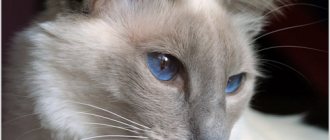The Balinese cat breed is distinguished by its intelligence and cheerful disposition. But their character is very demanding in relation to their owners. These pets are sociable, affectionate, quickly become attached to their owner, and expect care and affection from him. They are active and playful even in adulthood. Let's tell you a little about this beauty who loves to be in the spotlight.
Brief history of the breed
America is considered the birthplace of the Balinese. According to one version, they appeared as a result of a gene mutation. According to the second theory, Balineses were bred as a result of mating Angora and Siamese cats.
Serious work on creating a new breed began in 1950 on the initiative of Marion Dorset. Ten years later, Helen Smith joined her and suggested calling the resulting cats Balinese.
For a long time, the breed did not receive official recognition from the public. It was possible to register the Balinese only in 1970 thanks to the persistence and tenacity of the breeders.
Features of care
Balinese dogs do not require any unique or unusual care. They should be cared for in the usual ways, but properly.
Recommendations for proper care:
- Bathing, cleaning eyes, ears and nose.
- Regular brushing. Any cat will most enjoy combing its fur, combined with a pleasant body massage.
- Favorable living conditions. This cat is more of a domestic animal than a wild one. She will feel most comfortable in the constant conditions of an apartment. Of course, you need to take her for a walk on the street, but you should understand that she is not created for street life.
- Regular visits to the veterinarian.
- Maximum attention. You need to spend time together with your Balinese cat as often as possible. In this way, she will not only feel good, but also receive proper development, assimilating the necessary upbringing.
Interesting Facts
Although Balinese cats appeared relatively recently, they managed to associate a lot of interesting things with the breed:
- The name of the animals has nothing to do with the area where they were bred. It is associated with the appearance of cats, which with their grace resemble Balinese dancers.
- The color of the coat of representatives of this breed is influenced by a special gene, the activity of which changes with cold weather. Therefore, it is better to keep Balinese dogs in warm rooms with an air temperature of 22-24 °C.
- Kittens of this breed are born with short hair. The guard hair lengthens as the Balinese matures.
Content
Balinese cats are unpretentious to their living conditions. The main thing for them is a warm home, regular feeding, love and respect from their household.
Housing and walking
A Balinese cat will be equally comfortable in a city apartment or in a country house. The main thing is that the room is warm, because the cat has no undercoat and quickly freezes outside during the cold season. In warm weather, the Balinese can be taken for a walk on a leash in a fenced front yard or garden.
It is permissible to take Balinese cats outside, but they also feel comfortable in apartment conditions.
Ideal host
The ideal owner for a Balinese kitten will be an active, cheerful person who will love and care for him. Balinese do not tolerate loneliness well, so owners who disappear at work until late at night are better off getting a representative of a more phlegmatic breed, for example, a Persian or a British one.
Balinese cats will wither away without their owner's attention
Ambient temperature
The optimal temperature in the room for keeping the animal should be between 22 and 24 °C. While staying in a cold room, the activity of a specific gene responsible for color decreases in a cat, as a result of which its fur acquires a darker shade.
In cold conditions, the Balinese's coat darkens
Toys
Balinese, like a small child, constantly demands attention and loves active games. This funny creature will turn any object that comes under its paw into a toy. Toys for a cat should be simple (small balls, plush mice, paper bows on a string), but there should be a lot of them so that the pet does not get bored.
The Balinese will compensate for the lack of games with the owner with tricks of his own taste.
When a cat is bored, he begins an active search for adventure: he jumps on high cabinets, walks along the top shelves, tries to open drawers and take out all sorts of small objects suitable for games.
Video - Breeder about caring for Balinese cats
Breed description, standards, appearance
The Balinese cat has a graceful, athletic build and well-developed muscles. Visually, it is very similar to the Siamese, only with longer hair. The first breed standard appeared in 1967. It regulates not only the exterior, but also the behavioral characteristics of the Balinese.
Dimensions and weight
Representatives of the Balinese breed are not large animals. Females weigh on average 3.5 kg. Cats of this breed are heavier: the body weight of an adult male is about 5 kg.
Anatomical characteristics
Pedigree Balinese cats must meet the following description:
- The head is small, wedge-shaped with a narrowed, elongated muzzle, straight profile, pointed chin, high prominent cheekbones and a strong lower jaw.
- The eyes are almond-shaped, expressive, and slanted. The color of the iris is blue or blue.
- The ears are triangular, erect, disproportionately large. They have rounded tips and are a harmonious continuation of the wedge-shaped head.
- The body is stretched, slender with well-developed muscles.
- The limbs are thin, long with small oval paws. The front ones are slightly shorter than the rear ones.
- The tail is thin and long. Visually resembles a whip. Decorated with plumes.
Color and coat type
The body of a Balinese cat is covered with shiny, silky hair. On the chin, tail and neck of the animal, the hair is slightly wavy.
The colors of the Balinese can be varied. The most common colors found in the breed are:
- frost point;
- brown (chocolate) point;
- seal point;
- blue point;
- tabby
On a note. Balinese kittens are born with a uniform coat. The formation of color is completed by 12-18 months.
Possible breed defects
The disadvantages of the exterior of Balinese cats include:
- strabismus;
- kinks on the tail;
- dark spots on the stomach;
- white fingers;
- lack of markings on paws and muzzle;
- solid black or red color.
Balinese dogs with at least one of the above defects are not allowed for exhibitions and are not used for breeding.
Story
The history of the emergence of the Balinese cat cannot be imagined without the history of the beloved Siamese.
The first half of the last century can be considered the origin of this breed. It was then that American breeders of Siamese cats noticed that some litters produced individuals with long hair, which was not typical for Siamese cats. At first, such kittens were rejected and the appearance of Siamese cats that differed from generally accepted standards was hidden. But later, breeders, captivated by the beauty of the furry babies, decided to develop a new breed based on them. Its first name was Siamese Longhair, but eventually the name Balinese was assigned to the new cat breed. Already in 1967, the first standard for such cats was established, but in our country the first blue tabby point Balinese appeared only more than twenty years later - in 1988.
Character and temperament
Balinese cats are sociable, curious and intelligent creatures. Thanks to their natural flexibility and acrobatic abilities, they can easily climb tall cabinets and other hard-to-reach places in search of interesting objects.
Balinese cats need constant communication with people and love to be the center of attention. They quickly become attached to their owners and do not tolerate loneliness well.
Balinese cats are not as violent and selfish as their Siamese relatives. By temperament type, representatives of this breed are true sanguines.
Balinese are energetic, active animals that never get discouraged.
Breed and children
The Balinese cat gets along well with the owner's kids. Especially if children understand how to properly communicate with a pet and do not offend it.
He will be happy to play with them. But if the kids start squeezing the Balinese or carrying it in their arms, the cat may show its claws.
Breed and other animals
Balinese cats have always lived close to people and never foraged for food in their natural environment. Therefore, they do not have developed hunting instincts and are calm towards other animals.
Balinese cats get along well with a variety of pets, from dogs to rodents.
Characteristics of Balinese cats
Experts call the Balinese cat the smartest among all representatives of long-haired breeds.
She is distinguished from her peers by her high intelligence and excessive curiosity. Getting somewhere or getting something you like is not difficult for a Balinese. So, it is better to hide valuable items, and close cabinets and doors more tightly. On the other hand, pets are trainable and love when their owner works with them.
Balinese kittens are very active and playful. These intricate cat lovers will always be able to find entertainment for themselves - be it a hunt for a rustling candy wrapper or an interested observation of life outside the window. For fun, they need a spacious room, otherwise the furry ones will adapt home furniture for games. Breeders don’t always like this, so household members should think in advance about what peaceful direction to direct the energy of a purebred dog and how to diversify its leisure time.
Balinese cats are talkative, they have a pleasant, musical voice, rich in intonations. They love communication and are truly attached to their family. Therefore, leaving the cat alone for a long time is not recommended. The pet will strive to spend as much time as possible next to members of the household. And it doesn’t matter to him at all what they are doing at that moment - basking in bed on a Sunday morning or walking in the fresh air.
Balinese pets are kind, polite and not aggressive. They easily find a common language with children and other animals. Both of them become companions in noisy entertainment for the descendants of the Siamese. However, the cat will not allow itself to be squeezed, and if someone shows disdain towards it, it can stand up for itself.
How to choose the right kitten
Balinese cats are a fairly rare breed. Therefore, it is better to buy such an animal in a specialized nursery or from a professional breeder with a good reputation. Before purchasing a small Balinese, you need to read the documents and look at the conditions of its maintenance.
A healthy kitten is large, active and very mobile. He shows no fear and is interested in everything that happens around him. The little Balinese has a soft belly, clear, non-squinting eyes, pink gums, an even tail without knots or creases, clean skin and fresh breath.
Kitten care
A small Balinese requires more attention than an adult animal. Usually he gets into a new home no earlier than 3 months of age and by this time he is already accustomed to the tray and scratching post.
To make caring for your pet easier, before his arrival, purchase:
- bowls for food and water;
- bed or house;
- tray and filler;
- scratching post;
- carrying bag;
- toys;
- cosmetics (shampoo, toothpaste, etc.).
To prevent the tailed pet from causing trouble in the future, it is immediately taught the rules of behavior in the house and hygiene procedures.
Character
Siamese and Balinese may differ in the length of their coats, but underneath they are identical. Balinese people love their family very much. They love to be “helpful” and will watch your every move. As soon as the owner sits down, the Balinese will immediately climb onto his lap, and at night he will also not leave his person alone, but will most likely crawl under the blanket and put his head on the pillow.
This cat will get underfoot a lot, so it may not be the best choice for people who are unsteady on their feet or who use aids (such as canes) to get around. The Balinese may not be as boisterous as their Siamese cousins, but they are definitely just as stubborn. Your pet will definitely remind you that it needs attention. You can also count on him to "tell everything" to guests, so be grateful that most people don't know cat language.
Balinese are very intelligent, active and athletic animals who love to play. The pet must always be busy with something. Puzzle toys will help with this, as well as games in which the cat can chase. A large tree is a great way for a cat to stay fit.
This animal can walk on a leash and easily learns various tricks. Never leave your pet alone without any entertainment, otherwise you risk a trashed house. If you like to chat with someone during the day, Balinese can be your best friend. Just make sure you have time to pay attention to this demanding and social cat. Balinese people don't mind staying at home during the day while you go to work, but they expect you to pay attention to them when you get home.
To prevent your pet from feeling sad alone, a great option would be to get another Balinese. This loyal and loving cat, given the right conditions, can make a great friend.
Care and maintenance
Representatives of the Balinese cat breed do not have an undercoat, which provides reliable protection from the cold. Therefore, they are completely unsuited for life on the street and are suitable exclusively for indoor keeping.
Caring for Balinese cats is not particularly difficult and comes down to proper feeding and hygiene.
Hygiene procedures
In order for the Balinese cat to look aesthetically pleasing, it is provided with appropriate care:
- The animal's eyes and ears are regularly wiped with a moistened cotton pad and inspected for unusual discharge. If balinese pus is detected, be sure to show it to a veterinarian.
- To prevent plaque and tartar from forming on your cat’s teeth, they are cleaned weekly with a silicone brush and a special paste that does not foam.
- Although Balinese dogs grind their nails down on their own, they are trimmed regularly to keep them looking well-groomed.
Grooming
To prevent the Balinese cat's fur from becoming tangled, it is combed several times a week with a special comb. During molting, the procedure is carried out more often than usual in order to speed up the loss of dead hair and the growth of new integument.
Since Balinese cats take care of the cleanliness of their coats on their own, they do not need frequent washing. Cats of this breed are bathed 2-3 times a year. The procedure is carried out in a warm room, away from drafts.
The wetted Balinese wool is lathered with a special shampoo and then rinsed with non-hot water. The bathed cat is thoroughly dried with a towel.
On a note. A hairdryer can dry out the silky Balinese coat. Therefore, it is better to refuse its use.
Tray
Balinese cats are not large animals, so both open and closed trays are equally suitable for them. But the choice of filler must be taken with special responsibility.
It must be of high quality and have good absorbent properties. Low-quality mineral or wood fillers are not suitable for long-haired Balinese. Such granules quickly become soaked and turn into an incomprehensible substance that sticks to the cat’s tail and paws and spreads throughout the house.
Reviews from owners of Balinese cats
Valentin, 24 years old, Samara
When she came of age, her parents gave her a kitten of the Balinese breed. Before that time, I had never owned an animal, so I didn’t know how to care for it. I read the literature, bought a scratching post, combs and special shampoos.
The kitten grew quickly, at first he was given dry food, but after a prolonged intestinal disorder he switched to natural food. The animal is affectionate, loves to play and sleeps in the same bed with its owner. I try to comb it every 2-3 days, I bathe the animal once a week. The cat is clean and quickly learned to use the litter box.
Irina, 43 years old, Ekaterinburg
My son asked me to buy a pet. We spent a long time choosing and decided to buy a Balinese kitten. They searched for a nursery for a long time and found it in a nearby large city. A breeder came to meet us and told us what to look for when buying an animal. All accompanying documents were issued, the kitten had a slightly uneven color, so the price was slightly reduced.
The cat is growing quickly, we try to feed only the food that the veterinarian has selected. The animal is playful, active, loves to play hide and seek, and can run around rooms all day. He got used to the tray within a few days, and tolerates bathing steadily, without disturbance.
Feeding the cat
Not only its health, but also its appearance depends on the quality of the Balinese’s diet. In order for the cat to develop properly and have beautiful fur, it is provided with a balanced menu.
Complete diet
It is most convenient to give your Balinese cat premium or super premium industrial food. It contains all the vitamins and microelements necessary for the normal development of the pet.
The main thing is that it does not contain dubious additives such as soy, dyes or flavor enhancers. These requirements best meet:
- Royal Canin;
- Acana;
- Pronature.
When feeding a Balinese cat with natural products, the diet is designed so that different types of meat predominate in it. The animal is also given:
- porridge;
- vegetables;
- eggs;
- dairy products.
It is strictly forbidden to treat Balinese with sweets, river fish and leftovers from the master's table.
Important! Contrary to popular belief, an adult Balinese cat should not be given fresh milk. It can cause indigestion in the animal.
Feeding frequency
A kitten of this breed eats little by little, but often. Therefore, the frequency of meals depends on the age of the balinese:
- up to 6 months – 4 times a day;
- 6-12 months – 3 times a day;
- over 12 months – 2 times a day.
Vitamins and minerals
It is advisable to give a Balinese cat that eats natural food additional vitamins twice a year. The use of such complexes helps to activate hair growth, improve skin condition and strengthen the animal’s bones.
They are selected taking into account the individual needs of a particular balinese and given in dosages recommended by the veterinarian.
Best suited for Balinese cats:
- 8 in 1 Excel Brewer's Yeast;
- Beaphar Kitty's Mix;
- Canina Canivita;
- Polidex Immunity up.
Application
The Balinese cat breed is recommended for families with small children.
This pet is suitable for an active and cheerful person.
It is worth considering that Balinese are incredibly playful, sociable and do not tolerate loneliness well.
Therefore, if the owner is not at home for a long time, it is better to get a kitten of a different breed, for example, a phlegmatic Scottish Fold or Scottish Straight .
Health and susceptibility to disease
Balinese cats are strong animals with good immunity. With proper care, representatives of the breed live 15-20 years and remain active for a long time. But, like any other cats, Balinese cats are prone to certain health problems.
Most often found in the breed:
- bronchial asthma;
- dysplasia of the elbow and hip joints;
- diabetes;
- gingivitis;
- amyloidosis of the kidneys and liver.
Psychology
The Balinese cat, a photo of which can be seen in the article, has an obstinate character.
It is characterized by both independence and pronounced hunting characteristics.
These animals become strongly attached to their owners, but do not tolerate too intrusive affection.
It is especially important to explain the rules for keeping Balinese dogs to children.
Such a cat should not be treated like a soft toy.
Otherwise, you can get a lot of scratches and bites.
If other animals appear in the house, including ferrets, degus or lemmings , it is reasonable to expect jealousy on the part of the Balinese cat.
They are reluctant to make contact with strangers.
Balinese dogs can hardly tolerate the long absence of their owner; they really like attention.
Therefore, when you return, it’s worth playing a little with the cat or treating it to a delicacy.
Balinese cats need good training, but they do not forgive undeserved punishment.
In general, the Balinese is a sociable, intelligent and energetic pet.
He will be a wonderful play partner and assistant in all household chores.
Balinese is looking forward to his owner
Vaccinations and antiparasitic treatments
To protect the Balinese cat from viral and infectious diseases, it is regularly vaccinated. To do this, a complex drug is introduced into the pet’s body to provide protection:
- from rhinotracheitis;
- viral leukemia;
- calcivirosis;
- panleukopenia;
- rabies.
The first vaccination of the Balinese is carried out at the age of 8 weeks, and the further schedule is agreed upon with the veterinarian. Vaccination is given only to completely healthy animals that have undergone preliminary antiparasitic treatment.
The Balinese cat is protected from fleas using a collar, drops or shampoos. They are used strictly according to the instructions on the packaging.
To get rid of internal parasites, the Balinese cat is given anthelmintic drugs every 3-4 months, repeated every 10-12 days.
Balinese health
This breed is prone to the following diseases:
- Upper respiratory tract infections. The development of such diseases leads to negative consequences for the pet. To prevent this from happening, it is necessary to maintain warm and dry conditions at home . When taking an animal from the nursery, you need to carefully examine it so that nothing stands out from the nose, eyes and ears, and especially the animal should not wheeze. You can, of course, buy a sick cat and try to cure it, but it is not advisable for families with children to act in such a humane manner.
- Strabismus. Most of all it can be described as a flaw, but not as a serious disease. Because strabismus does not negatively affect the health or behavior of the animal. Sometimes kittens are born with it, but it goes away with age. In general, due to the narrow muzzle and slanted eyes, Balinese cats may appear cross-eyed, but are not so.
- Other diseases. Purebred Balinese may have some genetic abnormalities. As a rule, they do not pose much of a threat.
Pros and cons of the breed
Like any other cat, Balinese cats have both positive and negative traits.
| Advantages | Flaws |
| Easy to care for | Poor tolerance of loneliness |
| Cleanliness | Tendency to certain health problems |
| Kindness and sociability | Excessive mobility |
Balinese cats are attractive animals with a cheerful, easy-going character. Beautiful appearance, sociability and cleanliness make the breed an ideal option for people thinking about buying a furry pet.
Characteristic
The main qualities and features of the Balinese cat breed on a 10-point scale:
- family attachment 8/10
- shedding intensity 6/10
- general health 4/10
- playfulness 8/10
- tendency to vocalize 2/10
- good attitude towards children 8/10
- good attitude towards strangers 8/10
- ease of care 8/10
- friendliness to other pets 8/10
Buying a Balinese kitten
The cost of kittens varies.
This is a rare breed for Russia, therefore, if you are planning to buy a Balinese kitten, even just “for the soul,” be sure to check the documents for the animal.
There are advertisements for the sale of Balinese kittens for 2000-5000 rubles.
The price is, of course, attractive, but most likely you will be deceived.
Externally, cheap kittens look like real Balinese, but this does not mean that this is the same unique breed.
Casual breeders may not take care to check animals for genetic diseases, as a result of which offspring may appear with strong deviations from the standard characteristics inherent in a pure breed.
Thus, future kittens may have disqualifying characteristics.
There are few nurseries that breed this breed, but here you have a better chance of buying a real, purebred Balinese kitten. Prices are correspondingly higher.
pet-class kittens from the nursery is 10,000-15,000 rubles. This type includes kittens for home and family .
In the future they will not be able to participate in exhibitions and breeding at the official level.
Other classes of kittens - show and breed - will cost more: about 15,000 rubles and more .
Small Balinese kittens become independent after 12 weeks of birth. Before this, they are strongly attached to their mother cat. Therefore, competent breeders give buyers already matured, three-month-old kittens.
At this age, their difference from their Siamese brothers—their fur—is more clearly evident. Little Balinese dogs are ready to explore their new home and meet their owners.
Reviews
Lucy
My Balinese Lucienne (yes, named after herself, her beloved) is simply a fiend (in the best sense). In our family it is “customary” to keep Balinese dogs, and no one else had such “electric brooms”. Lucy is fast, predatory and bloodthirsty . Moreover, she doesn’t care whether it’s a piece of meat in front of her or your leg. He bites symbolically; simply, as we understand, he loves hunting with all his heart. And even more - the element of surprise: he loves to attack on the sly. Devilish traits, by the way, do not in any way affect our boundless love for her.
Alenka
A Balinese is not a cat, it's a dog ! My Bonita will easily watch over things, look after the house (this is the only way she drives away people she doesn’t know!), and the coolest thing is that she greets me with a slipper in her mouth! Moreover, in Bonka there is the soul not of a small dog, but of a big dog: wise, brave, kind . Although in appearance she is a real ballerina: graceful, thin, with a fluffy skirt.
If you have purchased a Balinese kitten, you need to try to choose a suitable cat name for it.
And in order not to make a mistake, learn to distinguish a boy from a girl by familiarizing yourself with the essential signs in this article.
Little kittens sneeze often. How dangerous is this?
Health
Balinese cats are susceptible to the same diseases as Siamese cats, as they belong to the general Siamese-Oriental group.
Balinese cats are prone to the following diseases:
- amyloidosis, caused by metabolic disorders and leading to dysfunction of the liver, adrenal glands, and digestive organs;
- strabismus that cannot be treated;
- asthma caused by allergies;
- skin asthenia, expressed in a lack of collagen, the formation of wounds on the skin;
- malignant neoplasms;
- hereditary heart disease, dilated cardiomyopathy.
In the absence of oral hygiene, Balinese cats develop tartar, which causes gum inflammation.
Representatives of the Balinese breed, like other cats, become infected with helminths if they are improperly fed and cared for. The problem can be eliminated by giving the animal anthelmintic drugs every 3 months.
In general, the Balinese have good health. With regular vaccinations, a furry pet can live up to 15 years.











